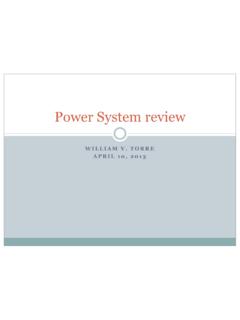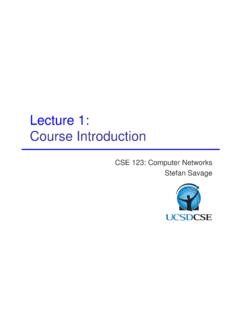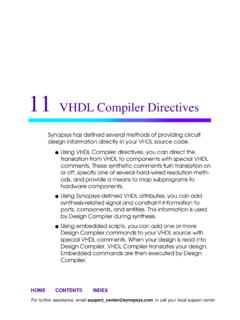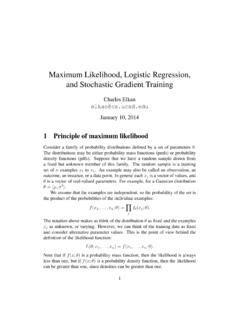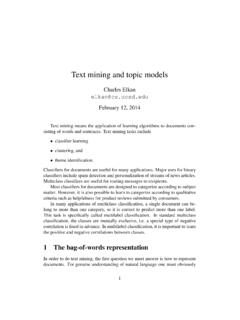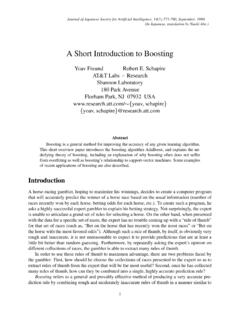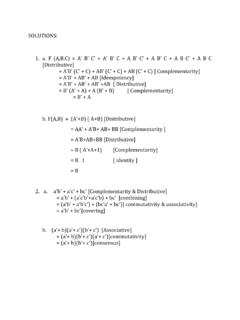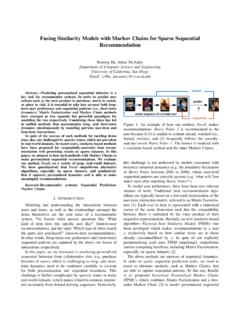Transcription of Internet of Things (IoT) - University of California, San Diego
1 Internet of Things (IoT)CSE237aClass Overview What ve covered until now in SW: Everything!!!!! Where we are going today: IoT Due today: Articles on IoT Upcoming: HW3 assigned Final project due Thursday Examthelastdayofclass;nobook/notes Bring one 8 x 11 sheet of paper with handwritten notes Course evaluations are out!!!! Please provide your feedback re. course we take your feedback very seriously and look forward to hearing from you!What is IoT? A phenomenon which connects a variety of Things Everything that has the ability to communicate3 Connection of Multiple Visions4 Source: Atzoriet al. 2010 IoT Definitions The Internet of Things , also called The Internet of Objects, refers to a wireless network between objects, usually the network will be wireless and self-configuring, such as household appliances.
2 (Wikipedia) The term " Internet of Things " has come to describe a number of technologies and research disciplines that enable the Internet to reach out into the real world of physical objects. (IoT 2008) Things having identities and virtual personalities operating in smart spaces using intelligent interfaces to connect and communicate within social, environmental, and user contexts . (IoT in 2020)5 IoT Evolution Starts with only network and evolves into everything that can be connected with a network6 Source: Pereraet al. 2014 Any-X Point of View The Internet of Things allows people and Things to be connected Anytime, Anyplace, with Anything and Anyone, ideally using Any path/network and Any : Pereraet al.
3 2014 Characteristics of Knowledge extraction from the generated A hybrid architecture supporting many system A diverse set of dynamically changing considerations considerations Billions of parallel and simultaneous considerations Consuming resources as a service8 IoT Layered Architecture9HW: Sensing And CommunicationSW: Middleware and ApplicationsSource: ZTEN etworking and Communication RFID to smallest enabling technologies, such as chips, etc. Mobile platforms, such as sensors, phones, : QianZhang. Lecture notes. 2013 wireless Technologies Telecommunication systems Initial/primary service: mobile voice telephony Large coverage per access point (100s of meters 10s of kilometers) Low/moderate data rate (10s of kbit/s 10s of Mbits/s) Examples: GSM, UMTS, LTE WLAN Initial service: wireless Ethernet extension Moderate coverage per access point (10s 100s meters) Moderate/high data rate (Mbits/s 100s) Examples: IEEE (a-g), Wimax11 Source: Geert Heijenk.
4 Mobile and wireless Networking. Lecture Notes. 2014 wireless Technologies Short range: Direct connection between devices sensor networks Typical low power usage Examples: Bluetooth, Zigbee, Z-wave (house products) Other examples: Satellite systems Global coverage Applications: audio/TV broadcast, positioning, personal communications Broadcast systems Satellite/terrestrial Support for high speed mobiles Fixed wireless access Several technologies including DECT, WLAN, , : Geert Heijenk. Mobile and wireless Networking. Lecture Notes. 2014 Sensor Networks (SNs) Consist of a certain number (which can be very high) of sensing nodes (generally wireless ) communicating in a wireless multi-hop fashion13 Source: Pereraet al.
5 2014 Sensor Networks (SNs) SNs generally exist without IoT but IoT cannot exist without SNs SNs have been designed, developed, and used for specific application purposes Environmental monitoring, agriculture, medical care, event detection etc. For IoT purposes, SNs need to have a middleware addressing these issues: Abstraction support, data fusion, resource constraints, dynamic topology, application knowledge, programming paradigm, adaptability, scalability, security, and QoS support14 Example: indoor localization An indoor positioning system (IPS) is a solution to locate objects or people inside a building using radio waves, magnetic fields, acoustic signals, or other sensory information collected by mobile devices.
6 For indoor localization : Any wireless technology can be used for locating GPS, WiFi, Bluetooth, RFID, Ultrawideband, Infrared, Visible light communication, Ultrasound15 Middleware Middleware is a software layer that stands between the networked operating system and the application and provides well known reusable solutions to frequently encountered problems like heterogeneity, interoperability, security, dependability [Issarny, 2008] IoT requires stable and scalable middleware solutions to process the data coming from the networking layers16 Service Oriented Architecture (SOA)17 Middleware solutions for IoT usually follow SOA approaches Allows SW/HW reuse Doesn t impose specific technology A layered system model addressing previous issues Abstraction, common services, compositionSource: Atzoriet al.
7 2010 Other Middleware Examples FosstrakProject Data dissemination/aggregation/filtering/inte rpretation Fault and configuration management, lookup and directory service, tag ID management, privacy Welbourneet al. Tag an object/create-edit location info/combine events collected by antennas e-Sense Project Middleware only collects data in a distributed fashion and transmits to actuators UbiSec&SensProject Focuses on security secure data collection, data store in memory, Problems and Challenges Lack of standardization Scalability Addressing issues Understanding the big data Support for mobility Address acquisition New network traffic patterns to handle Security/Privacy issues19 Standardization Several standardization efforts but not integrated in a comprehensive framework Open Interconnect Consortium.
8 Atmell, Dell, Intel, Samsung and Wind River Industrial Internet Consortium: Intel, Cisco, GE, IBM AllSeenAlliance: Led by Qualcomm, many others20 Scalability Number of devices increasing exponentially How can they uniquely be tagged/named? How can the data generated by these devices be managed?21 Addressing Issues Incredibly high number of nodes, each of which will produce content that should be retrievable by any authorized user This requires effective addressing policies IPv4 protocol may already reached its limit. Alternatives? IPv6 addressing has been proposed for low-power wireless communication nodes within the 6 LoWPAN context IPv6 addresses are expressed by means of 128 bits 1038 addresses, enough to identify objects that need to be addressed RFID tags use 64 96 bit identifiers, as standardized by EPCglobal, solutions to enable the addressing of RFID tags into IPv6 networks22 Encapsulation of RFID message into an IPv6 : Atzoriet al.
9 (2010)New Traffic to Handle The characteristics of the smart objects traffic in the IoT is still not known Important basis for the design of the network infrastructures and protocols wireless sensor networks (WSNs) traffic characterization Strongly depend on the application scenario Problems arise when WSNs become part of the overall Internet The Internet will be traversed by a large amount of data generated by sensor networks deployed for heterogeneous purposes extremely different traffic characteristics Required to devise good solutions for supporting quality of service23 Security24 Man in the middle attack Source: Atzoriet al. (2010) Data integrity Data should not be modified without the system detecting it Attacks on the node Memory protection Attacks over the network Keyed-Hash Message Auth.
10 Code The components spend most of the time unattended It is easy to physically attack them IoT components are characterized by low capabilities in terms of both energy and computing resources They can t implement complex schemes supporting security Authentication problem Proxy attack, man in the middle attack problemPrivacy How is it different than traditional privacy? Legislative issues Ethics issues Easy for a person to get involved in IoTwithout knowing Data can be stored indefinitely Current solutions are not enough Encryption, pseudo-noise signal, privacy broker25 Putting it all together26 Source: What the Internet of Things (IoT) Needs to Become a Reality, White Paper, by K.
